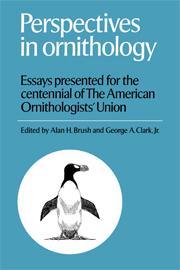 Perspectives in Ornithology
Perspectives in Ornithology Published online by Cambridge University Press: 04 August 2010
Community ecology is concerned with the patterns that characterize natural assemblages of species and understanding how these patterns came to be and how general they are in nature. The historical roots of community ecology lie in botanical studies of more than a century ago, but perspectives gained from investigations of birds have made major contributions to the development of the conceptual foundation that has guided and dominated activity in the discipline over the past quarter century. Avian studies have also contributed much of the evidence that supports community theory; in Schoener's (1974) review, for example, 34% of the 50 studies of resource partitioning in terrestrial animal communities cited were of birds. There is thus justification for considering the recent development, current problems, and future prospects of community ecology in the context of studies of bird communities.
In order to understand contemporary community ecology and its problems, it is necessary to consider its development over the past two or three decades. During the 1950s, two views of community structuring, each originally developed earlier in the century, were actively discussed, and each was expressed in studies of bird communities. On the one hand, ecologists following the view of Gleason (1917; see Mclntosh 1975) and Curtis (1959) suggested that the species within communities were arrayed along environmental gradients more or less independently of one another, each according to its own ecological requirements.
To save this book to your Kindle, first ensure no-reply@cambridge.org is added to your Approved Personal Document E-mail List under your Personal Document Settings on the Manage Your Content and Devices page of your Amazon account. Then enter the ‘name’ part of your Kindle email address below. Find out more about saving to your Kindle.
Note you can select to save to either the @free.kindle.com or @kindle.com variations. ‘@free.kindle.com’ emails are free but can only be saved to your device when it is connected to wi-fi. ‘@kindle.com’ emails can be delivered even when you are not connected to wi-fi, but note that service fees apply.
Find out more about the Kindle Personal Document Service.
To save content items to your account, please confirm that you agree to abide by our usage policies. If this is the first time you use this feature, you will be asked to authorise Cambridge Core to connect with your account. Find out more about saving content to Dropbox.
To save content items to your account, please confirm that you agree to abide by our usage policies. If this is the first time you use this feature, you will be asked to authorise Cambridge Core to connect with your account. Find out more about saving content to Google Drive.